Z-L-seryl-L-glycine ethyl ester is widely utilized in research focused on:
- Peptide Synthesis: This compound serves as a valuable building block in the synthesis of peptides, which are essential in drug development and biological research.
- Pharmaceutical Formulations: It is used in the formulation of pharmaceuticals, particularly in creating compounds that can enhance bioavailability and efficacy.
- Biochemical Studies: Researchers employ this chemical in biochemical assays to study enzyme activities and protein interactions, contributing to advancements in molecular biology.
- Cosmetic Applications: The compound is explored in cosmetic formulations for its potential skin benefits, such as moisturizing and anti-aging properties.
- Food Industry: It finds applications in the food sector as a flavor enhancer or additive, improving taste profiles while maintaining safety and quality standards.
General Information
Properties
Safety and Regulations
Applications
Z-L-seryl-L-glycine ethyl ester is widely utilized in research focused on:
- Peptide Synthesis: This compound serves as a valuable building block in the synthesis of peptides, which are essential in drug development and biological research.
- Pharmaceutical Formulations: It is used in the formulation of pharmaceuticals, particularly in creating compounds that can enhance bioavailability and efficacy.
- Biochemical Studies: Researchers employ this chemical in biochemical assays to study enzyme activities and protein interactions, contributing to advancements in molecular biology.
- Cosmetic Applications: The compound is explored in cosmetic formulations for its potential skin benefits, such as moisturizing and anti-aging properties.
- Food Industry: It finds applications in the food sector as a flavor enhancer or additive, improving taste profiles while maintaining safety and quality standards.
Documents
Safety Data Sheets (SDS)
The SDS provides comprehensive safety information on handling, storage, and disposal of the product.
Product Specification (PS)
The PS provides a comprehensive breakdown of the product’s properties, including chemical composition, physical state, purity, and storage requirements. It also details acceptable quality ranges and the product's intended applications.
Certificates of Analysis (COA)
Search for Certificates of Analysis (COA) by entering the products Lot Number. Lot and Batch Numbers can be found on a product’s label following the words ‘Lot’ or ‘Batch’.
*Catalog Number
*Lot Number
Certificates Of Origin (COO)
This COO confirms the country where the product was manufactured, and also details the materials and components used in it and whether it is derived from natural, synthetic, or other specific sources. This certificate may be required for customs, trade, and regulatory compliance.
*Catalog Number
*Lot Number
Safety Data Sheets (SDS)
The SDS provides comprehensive safety information on handling, storage, and disposal of the product.
DownloadProduct Specification (PS)
The PS provides a comprehensive breakdown of the product’s properties, including chemical composition, physical state, purity, and storage requirements. It also details acceptable quality ranges and the product's intended applications.
DownloadCertificates of Analysis (COA)
Search for Certificates of Analysis (COA) by entering the products Lot Number. Lot and Batch Numbers can be found on a product’s label following the words ‘Lot’ or ‘Batch’.
*Catalog Number
*Lot Number
Certificates Of Origin (COO)
This COO confirms the country where the product was manufactured, and also details the materials and components used in it and whether it is derived from natural, synthetic, or other specific sources. This certificate may be required for customs, trade, and regulatory compliance.

